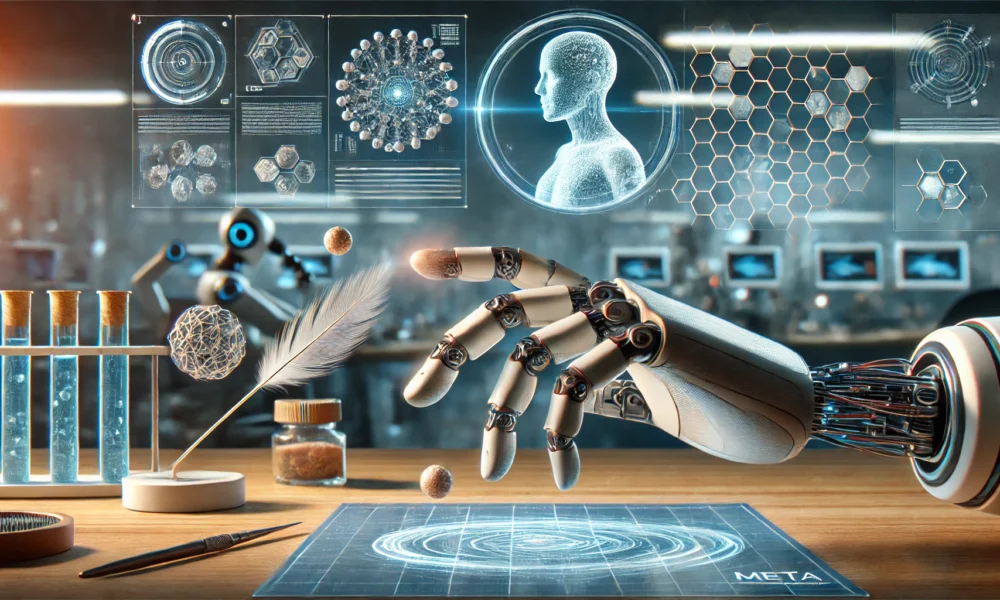Meta’s Bold Leap into Embodied AI: Redefining Human-Robot Interaction
Meta has set a remarkable course in the realm of artificial intelligence, particularly with its ambitious FAIR Robotics initiative. While AI has made significant strides in visual perception and language processing, it remains lacking in one critical aspect: the ability to interact physically with the environment. By tapping into our innate sense of touch—enabling nuanced awareness of texture, temperature, and weight—Meta aims to create AI that can perform delicate tasks with the same finesse as humans.
The Necessity of Touch in Robotics
Human dexterity is rooted in our ability to perceive the world through touch. This fundamental skill enables us to handle fragile items and tools deftly and perform intricate tasks seamlessly. Recognizing this gap in capabilities, Meta is directing its efforts toward developing embodied AI—an advancement that allows machines to not only see and hear but to feel and interact meaningfully with their surroundings.
Imagine a robot that can assist an elderly person in picking up a fragile piece of glass without risking breakage or an AI unit capable of assisting in precision surgeries. These applications highlight the transformative potential of embodied AI, transcending conventional robotic operations found in factories or labs.
What Is Embodied AI?
Embodied AI merges physical interaction with artificial intelligence, facilitating machines to respond and adapt to their environment in natural, human-like ways. It is no longer enough for machines to react to visual images or auditory signals; they must now be equipped to sense and act, enabling them to manipulate objects and engage seamlessly with people.
This evolution leads to a higher level of interaction, allowing AI to make real-time adjustments based on tactile feedback—essentially transforming how robots behave in dynamic environments.
Meta’s Three-Pillared Strategy
To make embodied AI a reality, Meta is focusing on three strategic areas:
- Advanced Tactile Sensing Technologies: Developing systems that accurately detect pressure, texture, and temperature.
- Touch Perception Models: Creating frameworks that enable machines to interpret sensory data effectively.
- Tactile Development Platforms: Designing integrated systems that can harmonize multiple sensory inputs with perception models.
These pillars are integral to making embodied AI both practical and effective in real-world applications.
Introducing Digit 360: A Revolutionary Tactile Sensor
Leading Meta’s efforts is the Digit 360, a groundbreaking tactile sensing technology engineered to deliver a human-like sense of touch. This fingertip sensor, equipped with over 18 sensing features, can detect vibrations, heat, and even the presence of chemicals on surfaces. With its AI chip, it processes information instantly, mimicking human reflexes and allowing for swift reactions to environmental changes.
Digit 360 contains a sophisticated optical system with over 8 million taxels, giving it microscopic sensitivity and enabling it to discern even the slightest force changes—important for delicate operations such as surgical procedures or delicate material handling.
Sparsh: The Touch Brain of Embodied AI
Meta’s Sparsh model serves as the cognitive hub for tactile perception. Named after the Sanskrit word for "touch," Sparsh helps machines interpret tactile signals such as pressure and grip. Unlike traditional systems that depend on specific models for individual tasks, Sparsh employs self-supervised learning on a vast database comprising 460,000 tactile images, allowing it to adapt flexibly across various applications.
Additionally, Meta’s TacBench will assess Sparsh using six precise touch-based tasks, revealing groundbreaking improvements compared to traditional models—highlighting a 95.1% performance boost, particularly in conditions with limited data.
Meta Digit Plexus: The Future of Tactile Systems
Introducing the Digit Plexus platform marks another significant advancement in tactile systems, integrating fingertip and palm sensors within a single robotic hand. This arrangement facilitates coordinated and immediate touch responses, elevating the capability of embodied AI to react appropriately, much like a human.
Standardizing responses across the robotic hand enhances precision in handling critical applications, particularly in manufacturing and healthcare, where every action counts. By seamlessly linking various sensors to a unified control system, Meta changes the game in tactile data interpretation and application.
Open Sources and Collaborative Innovations
To foster innovation, Meta is making its software and hardware designs for Digit Plexus available to the open-source community. By doing so, they aim to cultivate collaboration and expedite progress in embodied AI, paving the way for new breakthroughs that may revolutionize various industries.
Benchmarking AI for Real-World Applications
Beyond technological advancements, Meta is committed to enhancing research and development in embodied AI through rigorous benchmarking. The PARTNR initiative—Planning And Reasoning Tasks in human-robot collaboration—facilitates the evaluation of AI interaction during common household tasks using the Habitat 3.0 simulation. This approach not only assesses efficiency but also lays down the groundwork for improved human-robot collaborations across various contexts.
Partnerships for Progress
Meta’s collaboration extends to partnerships with industry leaders like GelSight Inc. and Wonik Robotics. Through these alliances, Meta aims to accelerate the adoption of tactile sensing technologies. GelSight’s distribution of the Digit 360 sensors and Wonik Robotics’ integration of Digit Plexus technology into manufacturing tools symbolize steps toward more intelligent and responsive robotic assistance.
Envisioning a Touch-Savvy Future
As AI continues to evolve, the integration of touch capabilities presents myriad possibilities. Meta’s advancements signal a future where robots can manage delicate tasks with ease and interact seamlessly with humans. This is but a glimpse into how embodied AI could redefine healthcare, manufacturing, logistics, and domestic assistance.
Conclusion: Building an Interactive Future with Embodied AI
Meta is at the forefront of the embodied AI revolution, providing machines with the ability to respond to stimuli akin to human touch. Innovations like Digit 360 and Sparsh showcase advanced tactile sensing and processing capabilities that promise to transform various fields. By sharing these developments openly and fostering community collaboration, Meta is not just accelerating the pace of change but is also laying the foundation for a future where AI plays a more substantial and nuanced role in our daily lives. This exciting frontier dreams of a world where machines not only assist but engage, making life easier, safer, and more productive.










